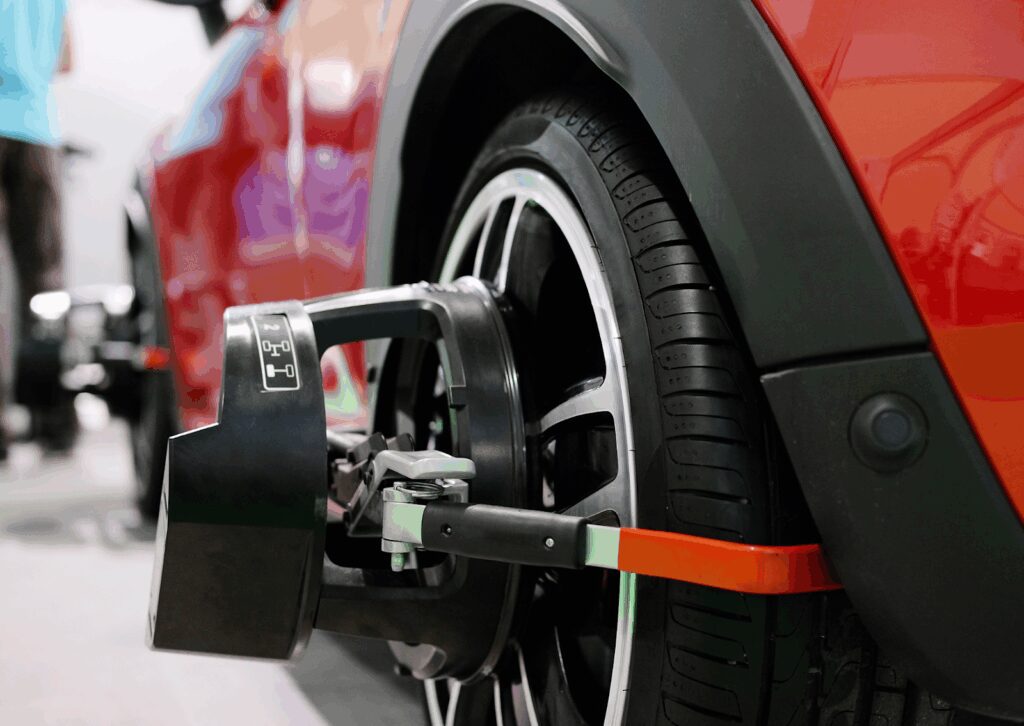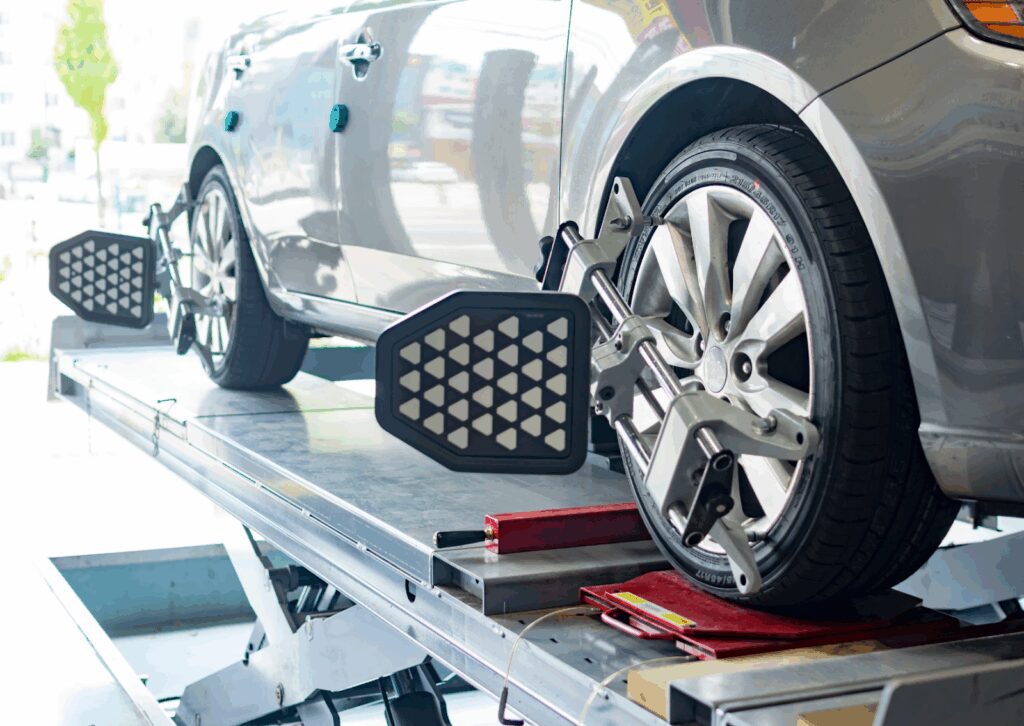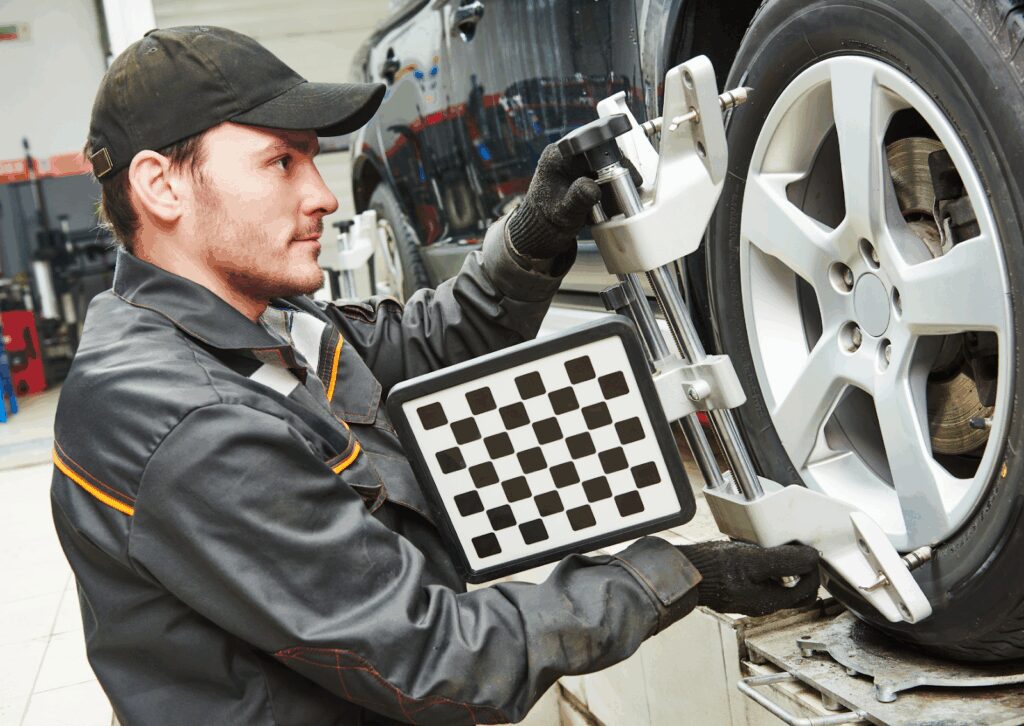At some point, we’ve all felt our car pull slightly to one side or noticed uneven wear on our tires. These are signs that something’s off beneath the surface, often pointing to a wheel alignment issue. At our shop, we’ve seen how neglecting proper wheel alignment can lead to premature tire wear, shaky steering wheels, and reduced vehicle performance. Whether you’re dealing with new tires, rough roads, or a simple maintenance check, understanding how alignment works and why it matters can save you time, money, and stress on the road.
What Is Wheel Alignment and How Does It Affect Your Car’s Performance?
What is Wheel Alignment?
Wheel alignment refers to the process of adjusting the angles of your vehicle’s wheels so they meet manufacturer specifications. These adjustments impact how your car drives, how your tires wear, and how much control you have on the road surface.
Why Does Wheel Alignment Matter?
Proper alignment plays a critical role in ensuring a smoother ride, better stability, and improved fuel efficiency. It also enhances vehicle performance, extends tire life, and protects the vehicle’s suspension. Poor or improper alignment can cause your vehicle to pull to one side, reduce handling control, and make your steering wheel feel off-center.
How Does Proper Wheel Alignment Improve Tire Life and Vehicle Safety?

Tire Wear and Safety
Misaligned wheels cause tires to wear unevenly, reducing tire longevity and overall safety. Tire wear that occurs on just the inside or outside edge is a sign of alignment issues, especially when combined with a steering wheel that vibrates or pulls.
Effects on Control and Braking
A misaligned steering axis affects how your steering systems respond, which could result in delayed braking and poor traction. This is particularly dangerous at higher speeds or in adverse weather.
Importance of Tire Longevity
Regular maintenance like tire balancing and regular wheel alignment helps protect the investment you’ve made in your tires, while also boosting overall performance.
What Are the Primary Alignment Angles and Why Do They Matter?

Camber, caster, and toe explained
There are three primary angles involved in vehicle wheel alignment:
-
Camber: The inward or outward tilt of the wheels when viewed from the front. Excessive positive camber or negative camber can indicate worn suspension parts.
-
Caster: The tilt of the steering axis when viewed from the side. A positive caster improves stability, while a negative caster can cause vehicle pulling.
-
Toe: The direction the wheels are pointed in relation to each other. Toe in and toe out affect how your car tracks straight and contribute to tire wear.
Why These Angles Matter
When the alignment angles are off, your car won’t handle well. Even small deviations from manufacturer specifications can lead to noticeable problems in steering, stability, and tire life.
How Is an Alignment Check Performed and What Tools Are Used?

Using an Alignment Machine
A modern alignment machine is used by trained technicians to measure and correct your alignment angles. This equipment ensures precision in adjusting the camber, caster, and toe.
Types of Alignments
-
Front-end alignment: Adjusts only the front two wheels.
-
Two-wheel alignment: Typically performed on rear-wheel-drive vehicles.
-
Four-wheel alignment: The most comprehensive option that adjusts all four wheels.
The Role of Trained Technicians
Only trained technicians can accurately interpret the data from an alignment check and make the necessary adjustments. They also inspect the suspension and steering systems for wear and damage.
What Is the Difference Between Tire Balancing and Wheel Alignment?

Definitions and Differences
Tire balancing involves correcting the weight distribution around each tire and wheel. Wheel alignment, on the other hand, adjusts the angle of the wheels so they are properly aligned with the steering axis.
When to Perform Both
If your car vibrates at higher speeds, you may need both tire balancing and wheel alignment. Doing both ensures better performance, a smoother ride, and less wear on your tires.
Why Both Are Necessary
Maintaining both services supports driving straight, extends tire life, and boosts vehicle performance by reducing steering effort and improving stability.
How Often Should You Get a Regular Wheel Alignment?

General Recommendation
A regular wheel alignment is recommended every 6,000 miles or whenever you install new tires. It should also be checked after a collision or hitting a pothole.
It May Vary Depending on Driving Habits
How often you need an alignment check may vary depending on how and where you drive. Rough terrain and frequent highway travel wear down the suspension and alter alignment angles.
Signs That It’s Time for an Alignment
Uneven tire wear, vehicle pulling, or an off-center steering wheel are clear signs you need an alignment.
What Are the Signs That You May Need a New Wheel Alignment?

Common Symptoms
-
Your car pulls to one side
-
The steering wheel isn’t centered
-
Uneven or rapid tire wear
-
You experience poor steering effort or reduced stability
Performance-related Signs
If your vehicle’s performance feels off or the ride isn’t smooth, you could be dealing with alignment issues. These issues can lead to costly damage to your vehicle’s suspension and steering systems.
Visual Inspection of Tires
Look for visible signs like feathering or excessive edge wear. These indicate misaligned toe angles, camber, or caster settings.
Do I Need an Alignment When I Get New Tires Installed?

Protecting New Tires
Yes. Getting an alignment check when installing new tires ensures you don’t ruin them with improper alignment.
Supporting Tire Longevity
Proper wheel alignment helps you get the full mileage from your new tires, while also boosting fuel efficiency and overall performance.
Metric Motors Recommendation
At Metric Motors, we strongly encourage every customer who invests in new tires to also consider a full alignment to protect that investment.
What Additional Services May Be Needed Along With a Wheel Alignment?

Tire and Suspension Inspections
During a standard alignment service, our team may also inspect the rear suspension, steering systems, and perform tire balancing.
Full Service Approach
Whether it’s adjusting the toe, camber, or caster, our trained technicians ensure every angle is adjusted for optimum performance.
Trusted Service Provider
Choosing a reliable service provider like Metric Motors means your vehicle is being evaluated thoroughly, not just for alignment, but for all related suspension and steering systems that affect your safety and vehicle performance.
Need an Alignment? Here’s What to Look for in a Service Provider

Choosing a Qualified Provider
Not all shops are the same. Look for:
-
Certified, trained technicians
-
Modern alignment machines
-
A focus on manufacturer specifications
Ask the Right Questions
Ask your shop whether they check both toe angles and steering axis tilts, if they offer four-wheel alignment, and whether they inspect your vehicle’s suspension.
Why Metric Motors is Trusted in Loveland
With decades of experience, Metric Motors in Loveland has built a reputation on honest service, cutting-edge tools, and a genuine commitment to keeping your car safe and running smoothly.
Final Thoughts
At Metric Motors, we understand how essential proper wheel alignment is to your vehicle’s performance, safety, and tire longevity. Our goal is to keep you driving straight with confidence, knowing your tires, suspension, and steering systems are in top shape. Don’t wait for alignment problems to wear down your investment. Book your alignment check today and let our team of trained technicians help you get back on the road with a smoother ride and peace of mind.
Frequently Asked Questions:
1. What are the main signs that I need a wheel alignment?
Common signs include your vehicle pulling to one side, an off-center steering wheel, uneven tire wear, and a noticeable decline in handling or fuel efficiency.
2. How often should I get a wheel alignment?
A regular wheel alignment is recommended every 6,000 miles or whenever you install new tires. It’s also smart to schedule one after hitting a pothole or curb.
3. Is wheel alignment the same as tire balancing?
No. Wheel alignment adjusts the angle of your wheels for proper contact with the road, while tire balancing evens out the weight distribution of the tire and wheel assembly.
4. Do I need a wheel alignment when I get new tires?
Yes, aligning your new tires ensures they wear evenly and last longer. Skipping this step can lead to improper alignment and early tire wear.
5. What’s the difference between front-end, two-wheel, and four-wheel alignment?
- Front-end alignment adjusts only the front wheels.
- Two-wheel alignment is common for rear-wheel-drive vehicles.
- Four-wheel alignment adjusts all four wheels for maximum precision.
6. Can poor alignment really affect my fuel efficiency?
Absolutely. Misaligned wheels increase rolling resistance, which forces the engine to work harder and reduces fuel efficiency.
7. What are alignment angles and why are they important?
Alignment angles include camber, caster, and toe. Each affects tire wear, stability, and steering effort. Accurate angles ensure proper alignment and safe handling.
8. How long does a wheel alignment take?
Typically, a wheel alignment takes about 1 hour. However, if additional services like suspension repairs or tire balancing are needed, it may take longer.
9. What causes wheels to become misaligned?
Potholes, curbs, rough road surfaces, worn suspension parts, and even accidents can all throw off your alignment angles.
10. Why should I choose Metric Motors for my alignment service?
Metric Motors uses advanced alignment machines, employs trained technicians, and follows manufacturer specifications to ensure your vehicle gets precise, reliable care.





